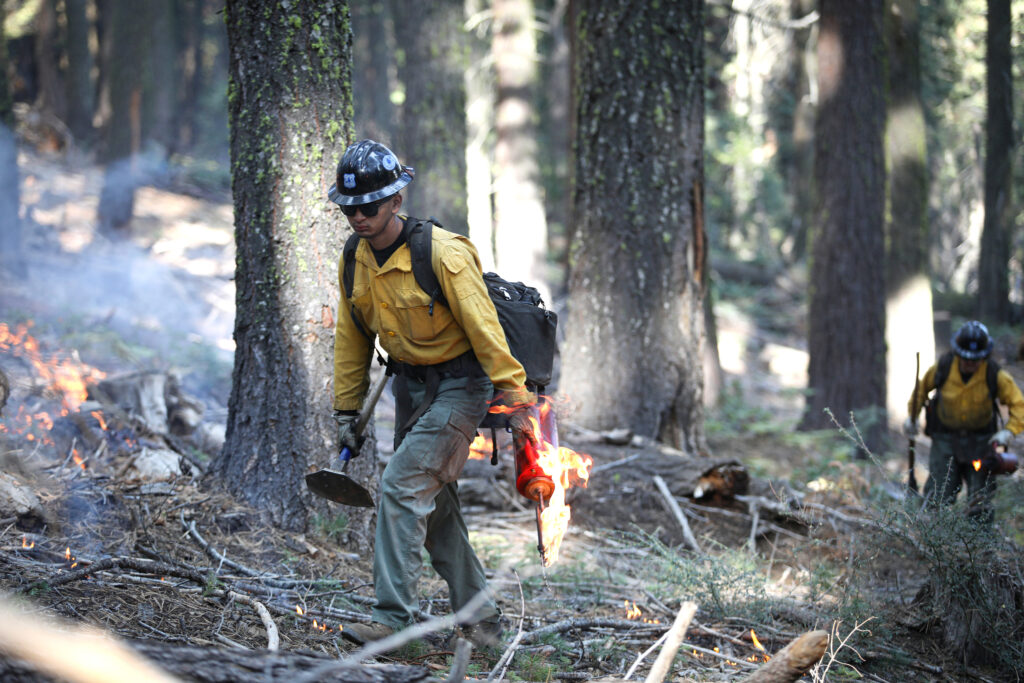On Sept. 16, the United States Forest Service (USFS) announced a hiring freeze for the next fiscal year, meaning the agency won’t be able to hire any seasonal employees in 2025. The decision stems from budget shortfalls as appropriations from Congress fell about half a billion dollars short of the Forest Service’s request and impacts around 2,400 seasonal positions, including employees who perform trail work, facilities maintenance and ecological and climate research. The freeze will not, however, affect the hiring of the Forest Service’s 11,300 seasonal firefighters.
USFS seasonal staff are essential for implementing projects like reforestation, wildfire mitigation, climate monitoring and carbon sequestration research—efforts that directly address climate change. Conservationists are worried that this temporary hiring freeze will have long-term impacts.
“We all know when we put off an important project around the home, it can cost even more money to address in the future,” said Josh Hicks, director of conservation campaigns at The Wilderness Society. “It’s the same with land management, only we’re talking about needlessly wasting the American taxpayer’s money.”
Climate change has created hotter and drier conditions across the Western U.S., leading to larger and more intense wildfires. While the seasonal firefighting staff won’t be impacted, fire mitigation workers, who try to prevent fires from igniting on Forest Service lands or make them less likely to burn severely, will. This is a major concern as the 10 years with the largest acreage of U.S. land burned have all occurred since 2004, according to the EPA, indicating a trend toward more extensive wildfires in recent years. In 2017 alone, the USFS reported 6,617 fires that burned approximately 2.87 million acres, accounting for 10 percent of all wildfires and 29 percent of all acreage burned nationwide that year. While data isn’t available for 2023, in 2022, federal lands accounted for 52 percent of the total acreage burned nationwide, with the USFS managing a substantial portion of those areas.
Seasonal USFS staff assist in removing deadwood and underbrush, which helps mitigate wildfire risk, in addition to conducting prescribed and cultural burns. Without this work, fuel loads in national forests would increase, potentially leading to wildfires igniting more easily or burning more intensely. Seasonal staff also help with post-fire restoration projects, such as tree replanting and soil stabilization. Conservationists are concerned that a reduction in the number of those workers could lead to more erosion and habitat loss.
According to a recent analysis by the Forest Service, fire has replaced logging as the greatest threat to mature and old-growth forests on the national forests and public lands.
“Human activities got us here, we need them to help get us out,” said Hicks. “Without human intervention, our forests will continue to burn at high severity, putting communities, human health, recreation, and natural resources at great risk.”
Hiring Freeze Could Impact Watersheds, Endangered Species and Carbon Sequestration
“We understand that this will have an impact that will reverberate across all national forests,” said Donna Nemeth, a spokesperson for the Forest Service’s Rocky Mountain Region. “While we wouldn’t want to speculate on long-term impacts, these seasonal positions cover a wide range of vital field work.”
In addition to fire mitigation, seasonal workers provide the bulk of assistance in monitoring and studying forest health. Seasonal employees track outbreaks of pests, like the mountain pine beetle, gypsy moth, spruce beetle and emerald ash borer, all of which have killed vast swaths of U.S. forests and released carbon stored in their trees. Without the work of seasonal employees, flammable invasive species like cheatgrass could spread, outcompeting native vegetation and altering ecosystems.
Seasonal workers also support projects like the recovery of the northern spotted owl and marbled murrelet in the Pacific Northwest and the reintroduction of native species like the bull trout and cutthroat trout in Western rivers. USFS seasonal workers have been instrumental in monitoring and mitigating the spread of white-nose syndrome, a fungal disease that has been devastating bat populations, but with reduced capacity for cave monitoring, bat population surveys and public education, some worry the disease could spread even faster.
The temporary workers also play a critical role in maintaining and monitoring watersheds and without their support, sedimentation and pollution in streams, rivers and lakes could increase, reducing the quality and availability of water both humans and ecosystems rely on.
The hiring freeze could also impact the amount of carbon stored by the roughly 193 million acres of national forests and grasslands managed by the Forest Service. Collectively, U.S. forests sequester hundreds of millions of metric tons of carbon dioxide each year, an amount equalling about 5 to 10 percent of the nation’s annual carbon emissions. The carbon sequestration provided by U.S. forests is estimated to be worth more than $100 billion over the next 35 years, a significant payoff considering the fiscal year 2024 budget request for the USFS was $9.7 billion for all of its work.
“Across the board, we are seeing public land agencies being asked to do more with less.”
— Chandra Rosenthal, Public Employees for Environmental Responsibility
Reduced data collection by seasonal staff who assist in monitoring carbon stocks and studying how forests sequester carbon could lead to gaps in research that delay the development of climate policy critical for U.S. resilience to the changing environment.
“If we adequately invest in our national forests, we get fresh drinking water, cleaner air, opportunities for outdoor recreation and natural climate solutions in return,” said Hicks. “But without the seasonal staff, we will see a dramatic loss in capacity to ensure our nation’s forests remain places that benefit communities, climate and biodiversity.”
And it’s not just conservationists who are concerned. Federal employees have pushed back at political claims of government bloat while its employment levels have been static.
“Across the board, we are seeing public land agencies being asked to do more with less,” said Chandra Rosenthal, a representative for Public Employees for Environmental Responsibility. “When federal employees are asked to do more with less, the cracks show in the climate battlefront—protection falters and ecosystems suffer. The hiring freeze at the Forest Service leaves important restoration and conservation work understaffed, undermining our national forests’ resilience.”
Many climate projects are staffed with seasonal workers but led by permanent employees as part of interdisciplinary teams, according to Nemeth. The Forest Service reports that it has been working hard over the last two years to stabilize its workforce, converting almost 1,300 non-fire seasonal workers to full-time employment.
“The Forest Service’s budget is provided primarily through discretionary appropriations provided by Congress each year,” said Nemeth. “As an agency, we have a responsibility to plan for the most conservative funding picture, and these actions reflect that reality. We are currently working on how this will affect each forest, and we will do everything we can to limit those impacts.”
While the Senate approved the USFS’ budget, the final appropriations that left the House were $500 million less than requested. And with the incoming Congress and Trump administration unfriendly to public lands and climate projects, as well as outspoken about minimizing government spending, the forecast remains dire.
The USFS’s chronic underfunding and heavy workloads that have been compounded by recent natural disasters like hurricanes and wildfires will continue to exacerbate issues across the agency and impact our nation’s forest health and climate resilience for years to come, Hicks said.
“It’s imperative we give the U.S. Forest Service the resources it needs to do its job,” he said. “Congress must provide the necessary funds to help the agency hire the workforce it needs, including these seasonal workers.”
About This Story
Perhaps you noticed: This story, like all the news we publish, is free to read. That’s because Inside Climate News is a 501c3 nonprofit organization. We do not charge a subscription fee, lock our news behind a paywall, or clutter our website with ads. We make our news on climate and the environment freely available to you and anyone who wants it.
That’s not all. We also share our news for free with scores of other media organizations around the country. Many of them can’t afford to do environmental journalism of their own. We’ve built bureaus from coast to coast to report local stories, collaborate with local newsrooms and co-publish articles so that this vital work is shared as widely as possible.
Two of us launched ICN in 2007. Six years later we earned a Pulitzer Prize for National Reporting, and now we run the oldest and largest dedicated climate newsroom in the nation. We tell the story in all its complexity. We hold polluters accountable. We expose environmental injustice. We debunk misinformation. We scrutinize solutions and inspire action.
Donations from readers like you fund every aspect of what we do. If you don’t already, will you support our ongoing work, our reporting on the biggest crisis facing our planet, and help us reach even more readers in more places?
Please take a moment to make a tax-deductible donation. Every one of them makes a difference.
Thank you,

